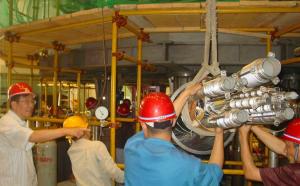From Russia with love
Building a tokamak is expensive. So when the opportunity arises to get one for free you jump on it, even if it means footing a hefty bill for dismantling the machine and shipping it overseas.
Such an opportunity presented itself to China in the late 1980s. "At that time, we only had very small machines to work with and very little funding," remembers Peide Weng, former Deputy Director of the Institute for Plasma Physics in Hefei, now in charge of integration in ITER's Tokamak Department. "In order to pursue our research, we needed a large superconducting tokamak—but of course, there was no way we could afford to build one."
At the Kurchatov Institute in Moscow, the Russians had been operating such a machine for the best part of the previous decade. The T-7 Tokamak, whose construction was completed in 1979-1980, was the first tokamak to demonstrate the feasibility of superconducting toroidal field coils. The complex architecture of the machine—48 toroidal field coils as compared to Tore Supra's and ITER's 18—left very little space for vacuum vessel ports and dramatically limited their size. The torus could only accommodate 12 small-sized ports which prevented T-7 from meeting the requirements for diagnostics, efficient heating and current drive. It was a good machine, only unfortunately not suitable for plasma physics research.
By the end of the 1980s, with the T-9 and T-10 tokamaks in operation and another, more powerful superconducting tokamak soon to be completed (T-15), the Russians did not really need T-7 anymore. "We had a longstanding relationship with the Kurchatov Institute—a very close and friendly one. At one point Boris Kadomtsev, who was head of the Institute, just offered to give it to us as a present."
It took more than three-and-a-half years to dismantle the machine, ship its parts to China, and redesign and upgrade it into an installation suitable for the needs of research. "We built a new vacuum vessel, and merged two of the T-7 double pancake coils into one four-pancake toroidal field coil. A "pancake coil" is a coil whose winding is arranged in the form of a flat spiral. ITER toroidal field coils will be configured as double pancake. By reducing the number of coils from 48 to 24 we were thus able to add 22 larger ports to the original 12. By 1994, we had a new machine that was twice the size of our previous HT-6M. We changed its name from T-7 to HT-7 — the "H" being for Hefei."
One of China's first steps toward exploring long-pulse plasma and steady-state operation in a superconducting tokamak, and an important milestone for their fusion research program, HT-7 is still in operation in Hefei. "HT-7 yielded great results: all the specified plasma parameters were realized. We achieved a 400-second discharge (50 kA), which is a very long plasma—much longer than we expected. More important for us is that we accumulated very valuable experience in superconducting tokamak operation and trained a batch of plasma physicists and fusion engineers."
Research on HT-7 enabled China to launch the HT-7U program for the first fully-superconducting tokamak, later known as EAST. And the example set by the Institute of Plasma Physics in Hefei wasn't lost: by 2002, the South-Western Institute of Physics in Chengdu was operating HL-2A, a reconstructed tokamak which uses the vacuum vessel and field coils from the former German ASDEX.


